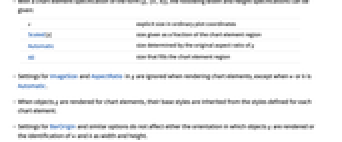is an option to charting functions such as BarChart that specifies the graphics to use as the basis for bars or other chart elements.


ChartElements
is an option to charting functions such as BarChart that specifies the graphics to use as the basis for bars or other chart elements.
Details


- Elements in charts can be based on any Graphics, Graphics3D, or Image object.
- The final rendered form of each chart element is obtained by replicating or stretching copies of the base object so as to fill the necessary shape or region.
- The following settings for ChartElements can be used:
-
None leave chart elements blank Automatic use a preset default graphic g fill chart elements with copies of g {g,All} stretch a single g to fill each chart element {g,{w,h}} use copies of g with width w and height h {g1,g2,…} use gi for the i  element in each dataset
element in each dataset{spec1,spec2,…} use different specifications for different data dimensions - With a chart element specification of the form {g,{w,h}}, the following width and height specifications can be given:
-
s explicit size in ordinary plot coordinates Scaled[s] size given as a fraction of the chart element region Automatic size determined by the original aspect ratio of g All size that fills the chart element region - Settings for ImageSize and AspectRatio in g are ignored when rendering chart elements, except when w or h is Automatic.
- When objects g are rendered for chart elements, their base styles are inherited from the styles defined for each chart element.
- Settings for BarOrigin and similar options do not affect either the orientation in which objects g are rendered or the identification of w and h as width and height.
- With ChartElements->{g1,g2,…}, the gi are used cyclically to render the chart elements for successive elements in each dataset.
- With ChartElements->{spec1,spec2,…}, the speci are used as chart element specifications for successive dimensions in nested lists of datasets.
- ChartElements->{g1,g2,…} is effectively taken to give a specification for the innermost dimension of nested lists of datasets.
Examples
Basic Examples (2)
History
Text
Wolfram Research (2008), ChartElements, Wolfram Language function, https://reference.wolfram.com/language/ref/ChartElements.html.
CMS
Wolfram Language. 2008. "ChartElements." Wolfram Language & System Documentation Center. Wolfram Research. https://reference.wolfram.com/language/ref/ChartElements.html.
APA
Wolfram Language. (2008). ChartElements. Wolfram Language & System Documentation Center. Retrieved from https://reference.wolfram.com/language/ref/ChartElements.html
BibTeX
@misc{reference.wolfram_2025_chartelements, author="Wolfram Research", title="{ChartElements}", year="2008", howpublished="\url{https://reference.wolfram.com/language/ref/ChartElements.html}", note=[Accessed: 08-October-2025]}
BibLaTeX
@online{reference.wolfram_2025_chartelements, organization={Wolfram Research}, title={ChartElements}, year={2008}, url={https://reference.wolfram.com/language/ref/ChartElements.html}, note=[Accessed: 08-October-2025]}